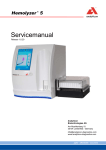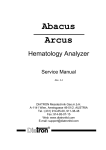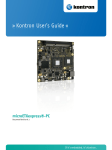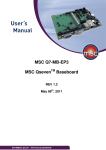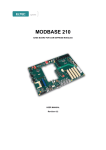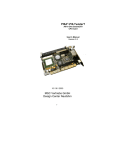Download ESC-407: FPGA Softcores: the Microcontrollers of
Transcript
FPGA Softcores: the Microcontroller of Tomorrow? Jerry H. Tucker Robert H. Klenke [email protected] [email protected] Virginia Commonwealth University Gene S. Monroe [email protected] NASA: Langley Research Center #407 Embedded System Conference – San Francisco March 29-April 1,2004 Page 1 INTRODUCTION The microprocessor has proved to be the most significant development in electronics since the invention of the transistor. The first microprocessors required many discrete logic integrated circuits (IC’s) to form a complete computer, but in 1976 Intel introduced the 8048 as the first 8-bit single-chip microcomputer [1]. The 8048 was soon superseded by the 8051, variations of which are still widely used today. Over the years single-chip microcomputers have undergone steady evolution and are available with a wide range price, performance and capability levels. This has enabled them to be used to implement countless embedded systems. In some embedded systems a microcomputer may not require other IC’s, but typically additional digital logic is required to accomplish the desired task. For complex systems, this additional logic may be substantial. By using a programmable logic device (PLD) the additional digital logic can be implemented in a single IC; thus, greatly reducing the chip count in embedded systems. Several years ago at NASA Langley Research Center in Hampton, Virginia we developed a radiation hard version of the 8051 and coupled that with a Xilinx field programmable gate array (FPGA) to be used in reconfigurable embedded systems. Not all embedded computer systems use a single-chip microcomputer. It has occasionally proved to be cost effective to dedicate a conventional personal computer (PC) to a single task; thus, effectively, making the PC serve as an embedded computer. It is quite common to implement high performance embedded systems using an industry standard backplane bus such as the PC-104. In addition miniature PC’s, smaller than PC104 modules, are available that can be used to implement embedded systems. It is possible to incorporating an FPGA’s into such systems to reduce component count and achieve reconfigurability. As an example, the authors have developed two such systems. The first one is a custom solution called the MERCAL (Minature Embedded Reconfigurable Computer And Logic) module [2,3]. The MERCAL module consists of a custom printed circuit board that contains a PC-based CPU board, in this case, a sub-credit card size DIMMPC from JumpTec, and a Xilinx FPGA. The programming pins on the Xilinx FPGA are directly connected to the parallel port on the DIMM PC, allowing it to re-program the FPGA at any time under software control. A group of the general-purpose I/O pins of the FPGA are connected to the PC’s ISA bus allowing for data transfer between the FPGA and the software on the PC during system operation. The application program that runs on the PC along with the FPGA configuration file can be uploaded to the PC so that the system is reconfigurable. A similar platform based on a PC-104 form factor has also been constructed by the authors and used in implementing a hardware/software application. In this case, a standard PC-104 CPU from WinSystems was combined with a Xilinx-based PC-104 FPGA board from Associated Professional Systems (APS). The APS board provides the capability for the CPU to program the Xilinx FPGA by transferring programming data across the PC-104 bus. Once programmed, like the MERCAL, the CPU and the FPGA can exchange application data across the PC-104 bus during system operation. These and similar systems are a precursor of a new way to think about digital system design. This new paradigm has arrived because of the steady increase in the #407 Embedded System Conference – San Francisco March 29-April 1,2004 Page 2 capability of FPGA’s. Today FPGA’s are available with the equivalent of over a million logic gates. With these resources it is now possible to implement complex digital systems, including one or more microcomputers, inside a single FPGA. This capability presents the embedded system designer with exciting new opportunities along with daunting challenges. STATE-OF-THE-ART Many programmable logic companies have introduced devices that allow the user to combine general purpose processing with programmable logic on the same chip. Some of these devices include a dedicated hard-core microcontroller with FPGA-based logic, and others, like the Xilinx Microblaze, rely on a soft-core microcontroller that can be implemented inside an FPGA with user logic. Atmel Corporation offers a device it calls the FPSLIC, or Field Programmable System Level Integrated Circuit. The FPSLIC device comes in several configurations, but all include an 8-bit AVR microcontroller, memory that can be used to store program data and code for the microcontroller, and FPGA resources that can be used to implement application-specific user logic. The Atmel AT94KAL devices combine the AVR microcontroller core with 36K bytes of SRAM that can be used for data and instructions, and SRAM-based FPGA logic that can implement up to 40K gates of logic. The AVR microcontroller is equipped with an 8-bit hardware multiplier, 2 standard serial UARTS, and two 8-bit and one 16 bit timer/counters that can be configured in various counter, capture, and PWM modes. The general purpose I/O ports of the AVR are connected into the FPGA for interfacing to user logic, and in addition, there are 16 address lines from the AVR into the FPGA to provide device addressing and selection and 16 interrupt lines lead from the FPGA back to the AVR. The AT94KAL devices are fabricated in a 0.35 mm, 5-metal layer, low power CMOS process and provide 3.3V 33MHz PCI compliant outputs. The AVR microcontroller is capable of 19 MIPS performance at a 25 MHz clock speed. To support the FPSLIC devices, Atmel offers the System Designer tool, which combines third-party design entry, simulation and synthesis tools with Atmel developed place and route tools and third party compilers to provide a complete environment for developing FPSLIC applications. One of the highlights of the System Designer environment is the capability to co-simulate compiled application code running on the AVR microcontroller with full debugging support, along with VHDL or Verilog models of the user hardware to be implemented in the FPGA portion of the FPSLIC device. Actel Corporation offers the Platform8051 environment for implementing hardware/software systems. The environment is based on a soft-core version of the industry standard ASM51 processor, a standardized 8-bit 8051 processor core. Actel also has a number of additional cores available to interface the 8051 core to a 10/100 Ehternet, UART, I2C bus, and Serial Data Link Controller (SDLC). Platform8051 includes the Actel Libro toolset for design entry, synthesis, place and route, and simulation, some of which are performed by included third-party tools, and a third-party compiler for the 8051 core. Radiation hardened hardware/software applications can be implemented in this architecture by utilizing Rad-Hard FPGAs available from Actel. #407 Embedded System Conference – San Francisco March 29-April 1,2004 Page 3 Altera Corporation offers the NIOS processor soft-cores for implementation in its programmable devices. The NIOS is a user configurable, general-purpose RISC processor which is available in 16-bit or 32-bit versions. Along with the NIOS core, Altera provides the SOPC Builder System which allows the user to accelerate timecritical software algorithms by adding custom instructions to the Nios processor instruction set. Using SOPC, the user can add up to five new instructions to the NIOS CPU using either existing resources inside the NIOS core, or the user can actually add custom hardware to the NIOS core to execute these new instructions. In addition, the custom hardware can access memory or logic outside of the NIOS system. In addition to SOPC Builder, Actel provides the NIOS Developers Kit which includes their Quartus II software tools for design entry, synthesis, place and route, and synthesis, and a version of the GNU software development tools tailored to the NIOS core. Xilinx provides tools for implementing both PowerPC and MicroBlace processors within their FPGA’s. This paper will focus on the MicroBlaze. THE MICROBLAZE PROCESSOR Although the MicroBlaze will typically be programmed in C/C++, it is helpful if not necessary for a successful designer to possess a through understanding of MicroBlaze architecture. Xilinx provides extensive online MicroBlaze and development tools documentation. This can be obtained form www.xilinx.com or specifically at http://www.xilinx.com/ise/embedded/edk_docs.htm. The material in this and the following section was obtained primarily form the MicroBlaze Processor Reference Guide available at: http://www.xilinx.com/ise/embedded/mb_ref_guide.pdf. MicroBlaze embedded soft core is a reduced instruction set computer (RISC) optimized for implementation in Xilinx field program able gate arrays (FPGAs). A block diagram of the MicroBlaze core is shown in Figure 1. Figure 1. The MicroBlaze core block diagram. The MicroBlaze consists of thirty-two 32-bit general purpose registers R0 to R31, and two 32-bit special purpose registers. The special purpose registers are the Program #407 Embedded System Conference – San Francisco March 29-April 1,2004 Page 4 Counter (PC) and the Machine Status Register (MSR). The general purpose register R0 is also special in that when it is read the value returned is always 0. Other general purpose registers such as R14, R16, and R17 have special purposes in servicing interrupts, exceptions, and breaks. The instructions are 32-bits and are divided into two types, Type A and Type B. Type A instructions usually have two source registers and one destination register. Type B instructions contain a 16-bit immediate value, along with a source register, and a destination register. For example the execution of Type A instruction ADD R1, R2, R3 causes the sum of R2 and R3 to be placed in R1. The execution of the Type B instruction ADDI R1, R2, 1234 replaces the contents of R1 with the sum of 1234 and the contents of R2. The MicroBlaze instructions are executed in a three-segment pipeline consisting of Fetch, Decode, and Execute stages. The pipeline effectively enables one instruction per clock cycle to be executed except in those cases, such as branches, where the normal pipeline flow is disrupted. Delayed branches are provided to reduce the branch penalty. Memory is byte addressable, using a 32-bit address, and data memory can be accessed as byte, half word (16-bits), or 32-bit words. Memory accesses must be datasize aligned. For halfword access the least significant bit of the address is forced to 0, and for byte access the two least significant bits of the address are forced to 00. MicroBlaze is a Big-Endian processor with bit 0 as the most significant or left most bit and word bit 31 the least significant or right most bit. Similarly the most significant byte of a word has the lowest address and the least significant byte has the highest address. It is possible to implement instruction and data caches, and the user has considerable flexibility in how these are configured. MicroBlaze also features a debug interface to support JTAG based software debugging tools. THE MICROBLAZE BUS INTERFACE Separate instruction and data buses are provided that conform to IBM’s OPB (onchip Peripheral Bus) specifications. As shown in Figure 3-1, there are separate bus interface units for data access and instruction access. Each of these bus interface units is split into a Local Memory Bus (LMB) and IBM’s On-chip peripheral bus (OPB). The OPB can be used to connect to both on-chip and off-chip peripherals and memory. The LMB provides for efficient synchronous block RAM (BRAM) transfers at rates up to 125 MHz for local memory systems. The MicroBlaze bus interfaces are available in six configurations as shown in Figure 2. MicroBlaze also provides 8 input and 8 output interfaces to Fast Simplex Link (FSL) busses. The FSL bus is used for dedicated communication channels. In Figure 2, IOPB and ILMB are the instruction interface to the OPB and LMB respectively. Similarly DOPB and DLMB are the data interface. The LMB is used for fast memory implemented internal to the FPGA. The OPB is use interface various #407 Embedded System Conference – San Francisco March 29-April 1,2004 Page 5 peripherals, that are implemented within the FPGA, including memory controllers that enable the use of large external memories. Figure 2. The six MicroBlaze bus configurations. DEVELOPMENT REQUIREMENTS In order to begin development of MicroBlaze applications the minimum set of required tools consists of the Xilinx Embedded Development Kit (EDK), the Xilinx Integrated Synthesis Environment (ISE), and a hardware development board. At the time of preparing this paper the latest version of the EDK is the recently released 6.1. This EDK also requires the separate ISE 6.1i. This software can run on Windows 2000, Windows XP, or Solaris 2.8/2.9. The MicroBlaze can be implemented in various Xilinx FPGA’s ranging from Spartan II to Vertex II Pro devices. Because of the FPGA resources required by the MicroBlaze it is probably unreasonable to select devices with less capability than the Spartan IIE, even as a learning platform. For serious applications, Vertex or Spartan-III devices should be selected. Hardware development boards can be obtained form several sources including Avnet, Digilent, Memec Design, and Xilinx. A Base System Builder Wizard provides support for a few selected boards, and can be used to simplify implementations based on these selected boards. An inexpensive first step learning platform, that we have found useful, is the Digilent DE2 development board which contains a 200,000 gate equivalent Spartan IIE combined with the Digilent DIO1 board. These boards are shown in Figure 3, and are available for a total cost of about $150. They do not contain memory external to the FPGA and the size of the FPGA limits the application complexity; however, they do provide sufficient capability to implement designs that will develop proficiency with MicroBlaze. At VCU we are using these boards in labs associated with the junior level Computer Engineering class in Digital Systems. Information on these boards is available #407 Embedded System Conference – San Francisco March 29-April 1,2004 Page 6 at http://www.digilentinc.com/, and it is expected that Digilent will shortly introduce inexpensive boards with larger FPGA’s. Figure 3. The Digilent DE2 and DIO1 boards. THE XILINX EMBEDDED DEVELOPMENT KIT The Embedded Development Kit (EDK) available from Xilinx provides the hardware IP for the MicroBlaze processor and its peripherals, the Embedded System Tools (EST), and associated documentation. Hardcopies of the documentation are not provided, but can found online or in the “doc” sub-directory of the EDK. The software tools necessary for MicroBlaze development are contained in the EST. A GUI, the Xilinx Platform Studio (XPS), is used to invoke the tools in the EST. With the XPS a user can configure the MicroBlaze processor and it’s busses, connect the desired peripherals, compile and debug MicroBlaze application source code using GNU tools, develop and simulate the required VHDL code, and download to the FPGA. A GETTING STARTED TUTORIAL Space here does not permit a complete tutorial on using XPS, but the first few steps are provided to give some indication of how the XPS works and to help get the reader started. We expect to make one or more extensive tutorials, based on the latest version of the EDK, available at http://www.people.vcu.edu/~jhtucker/. For this getting started tutorial, we will use the Platform Studio flow. It is based on the EDK 6.1i (SP2) with the ISE 6.1i (SP3) running on a Windows XP system. Xilinx currently provides, available at http://www.xilinx.com/support/techsup/tutorials/edk_tutorials.htm, an EDK 6.1 MicroBlaze tutorial using the Base System Builder Wizard for the Memec Design Virtex-II Pro board. Another useful tutorial, based on an older version of the EDK is available at http://www.eece.unm.edu/xup/spartan2emicroblaze.htm. #407 Embedded System Conference – San Francisco March 29-April 1,2004 Page 7 To use the XPS the steps are as follows: Shortcut to XPS_GUI.exe.lnk 1. Open the XPS by selecting: Start à Xilinx Embedded Development Kit à Platform Studio. 2. Select File à New Project à Platform Studio #407 Embedded System Conference – San Francisco March 29-April 1,2004 Page 8 3. We will target this design to run on the Digilab DE2 board containing a Spartan IIE XC2S200E in a PQ208 package. The design will be placed in the directory c:_MicroBlaze\ESC_example. Fill in the appropriate information in the Create New Project window and click on OK. When the windows appears asking if you want to start with an empty MHS file, click on Yes. After reading the next message box click on OK. #407 Embedded System Conference – San Francisco March 29-April 1,2004 Page 9 4. Select Project à Add/Edit Cores. 5. At this point you are able to add various peripherals (the MicroBlaze is included here) as IP cores to your design, set up the desired bus connections, set up the ports to connect the cores to the interconnecting buses. You should reference available tutorials for examples of how to accomplish these tasks. 6. The source code for your MicroBlaze application should be placed in the directory code using system.c as the file name. This is added to the project by selecting Project à Add Program Sources. 7. You may use Project à View Schematic to see a schematic representation of your architecture. 8. To implement the system you may use items under the tools menu or the appropriate buttons on the task bar. You may refine the technique later but initially you may want to use the following steps: 1. Tools à Clean à All. 2. Tools à Generate Libraries 3. Tools à Compile Program Source 4. Tools à Generate Netlist 5. Tools à Generate Bitstream 6. Tools à Update Bitstream #407 Embedded System Conference – San Francisco March 29-April 1,2004 Page 10 At this point you may configure and run on your hardware by opening the Impact program supplied with the ISE and download the file download.bit from the implementation directory. CONCLUSION Programmable logic devices have evolved to the point that they contain sufficient resources to implement microcontrollers, peripherals, and other logic within a single PLD. Thus, the ability to produce system-on-a-chip devices is no longer restricted to specialized ASIC designers. It is now possible, using relatively inexpensive tools, for any designer with the sufficient knowledge to implement complex reconfigurable embedded systems in FPGA’s. The answer the question posed by the title of the paper requires qualification. It is unlikely that FPGA softcores will entirely replace conventional microcontrollers; however, the advantages offered by this emerging trend are so great that in the future we expect it to be a dominant technology that cannot be ignored by embedded system designers. REFERENCES [1] MCS-51 Family of Single-Chip Microcomputers User’s Manual, Intel Corporation, July 1981 [2] Jerry H. Tucker, Robert H. Klenke, “An Embedded Reconfigurable Computer and Logic Module: Final Report for NASA Langley Research Center” NASA grant NAG1-01042, Virginia Commonwealth University, June 2002. [3] Robert H. Klenke, Jerry H. Tucker, Jason M. Blevins, “A New Hardware/Software Codesign Environment and Senior Capstone Design Project for Computer Engineering” 2003 International Conference on Microelectronic Systems Education, Marriott Anaheim, California, June 1-2, 2003. #407 Embedded System Conference – San Francisco March 29-April 1,2004 Page 11











